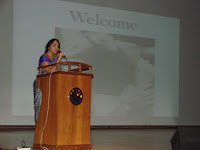The Counselling and Supportive Instruction Unit is all
set to implement the practice of inclusive classroom from the academic year
2013-14. In this endeavour, the unit organized a sharing a session by Ms. Sesha
Shailaja. She has been working with children who have learning difficulties
from the past twenty years and has immense exposure in inculcating inclusive
set up in a PYP classroom.
The session started with a note as to what is
meant by ‘inclusive education’ which is a process whereby the school systems,
strategic plans, and policies adapt and change to include teaching strategies
for a wider more diverse range of children.
Ms. Shailaja easily differentiated between
the two practices of ‘integration’ v/s ‘inclusion’ and gave certain principles
under which an ‘inclusive classroom’ can be a reality.
It was an enriching session for all which gave inputs
in implementing an inclusive classroom effectively.
This session was
followed by a lecture- demonstration by one of India’s leading dance therapist-
Dr. Tripura Kashyap. Dr. Tripura is a dance / movement therapist working with
children special educational needs.
The main purpose
of the demonstration was to un wrap the creative and therapeutic aspects of
dance in the field of education. The three important ways in which dance can be
useful, as elucidated by Dr. Tripura, are- personality development; to enhance
one’s creativity and innovation and teaching through dance.

She explained the way body movements can be used in the
classroom which, not only enhances learning but revitalizes the creativity of
each student and teacher.
Dance, which has to be learned not for a performance but as a process, can be
amalgamated in each subject a child is learning in class.
Simple usage of props such as balloons, sticks, and stretching ropes can make a
boring topic more interesting. Ms. Shashikala, a creative dance therapist,
demonstrated the movements using the props mentioned above. The demonstrations
included topics picked up from subjects included in a child’s curriculum such
as numeracy and literacy skills.
She imbibed Howard Gardner's concept of 'Multiple Intelligence' to express each
child's unique ability too.
The session proved
to be extremely beneficial for the homeroom teachers.










